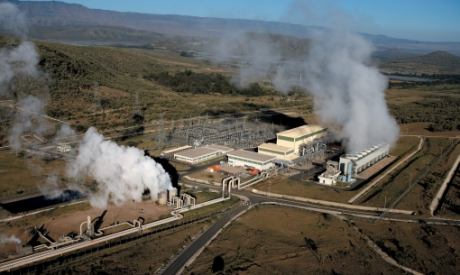
Kenya Steps Up Geothermal Power
October 3, 2012 - trust.org

A view of the Olkaria II geothermal power plant in Kenya’s Rift Valley. Photo: KenGen
By Geoffrey Kamadi
NAIVASHA, Kenya (AlertNet) – Kenya has inaugurated Africa’s biggest geothermal power project in a bid to meet its growing need for electricity and lower its consumption of nonrenewable energy.
The 280 megawatt (MW) Olkaria Geothermal Project was commissioned by Kenya’s president, Mwai Kibaki, in July. It is being built at a cost of 82.5 billion Kenyan shillings ($980 million) and is due for completion in June 2014.
Experts say that it should be an important source of “green” energy in a country that has seen its hydropower production hit by worsening drought.
The project “will be an effective source for power for Kenya in the sense that it will help the country manage its competitiveness in the region and in global markets, especially for agro-based industries that for many years have suffered from costly, inefficient and unreliable power,” said Chris Ackello Ogutu, an agricultural economist at the University of Nairobi.
If farmers get access to cheaper and more reliable geothermal energy to help process their crops, “then their vulnerability to climate change-related stresses (will) diminish,” he said.
Drilling of steam wells for the new facility has already taken place, and these will generate power even before the permanent geothermal plant has been put in place, officials say.
The new plant in particular will help Kenya reduce its heavy reliance on hydroelectricity, which is an increasingly uncertain energy source as rainfall becomes more erratic, a situation that experts believe is related to climate change.
Two geothermal units, each with an output capacity of 140 MW of electricity, will make up the new plant at the Olkaria Complex, some 80 km (50 miles) northwest of Nairobi, Kenya’s capital.
Two other geothermal plants constructed in the 1980s and 1990s are already in operation at the complex, which was Africa’s first geothermal project. The new plant will be Africa’s largest and will almost triple Olkaria’s capacity to 430 MW.
The project is being funded by the Government of Kenya, the Kenya Electricity Generating Company (KenGen), the World Bank, European Investment Bank, and the development agencies of France, Germany and Japan.
The geothermal project is expected to boost current Kenya’s power output of 1,588 MW by 18 percent, according to Eddy Njoroge, managing director of the Kenya Electricity Generating Company. The company is Kenya’s leading power generator, producing nearly 80 percent of the country’s electricity.
80 Percent Green Power
Njoroge adds that the project will increase the proportion of KenGen’s electricity derived from green sources to more than 80 percent. (The remainder comes from nonrenewable sources such as diesel generators.)
Geothermal power will contribute more than one third of this green energy.
The new project is one of several aimed at increasing the capacity of the national grid by as much as 140 percent over five years to help meet growth in demand. By 2030, the government plans to raise power output to 15,000 MW, from a current 1,500 MW.
“We have plans that in five years’ time we will be in a position to contribute more than 50 percent of our total electricity capacity (from geothermal power) so that the country can avoid expensive modes of generation,” Njoroge said.
Experts believe the Olkaria Complex could produce additional geothermal power beyond that now being tapped.
According to field optimization studies conducted by Mannvit Consortium of Iceland, the complex is capable of producing an additional 560 MW of power. Current estimates place Kenya’s total geothermal potential at 7,000 MW.
Nashon Adero, a policy analyst with the Kenya Institute for Public Policy Research and Analysis (KIPPRA), said the project is one of many green energy initiatives being promoted as part of the government’s Least Cost Power Development Plan, which looks ahead as far as 2031.
"Geothermal is seen as the preferred power generation for Kenya because its operation costs are less than other modes of power generation, and in the long run (it) can help the country achieve a reduction in unit cost of power by 50 percent," he said.
Geothermal power is less expensive than hydropower, he said, and will also significantly help reduce the country’s greenhouse gas emissions from fossil fuel power generation.
Emissions from geothermal power generation are just 10 percent of those from oil-based power generation, Adero said.
He said Kenya’s Great Rift Valley gives the country a competitive advantages in that it offers suitable geological conditions for harvesting heat from the earth’s crust to generate electricity.
"Even though sources of renewable energy in such countries as Ghana and the Democratic Republic of Congo are significant, these are mainly hydropower based," he said.
But Kenya lags behind other African countries in terms of per capita power availability, figures show. Kenya’s power availability, for instance, is less than half that of Ghana, according to the Kenya Economic Report of 2010, compiled by KIPRA.
And improving power generation alone will not improve the country’s economic prospects, Ogutu warned.
"Policy issues remain problematic and labour costs have tended to make Kenyan products a lot more expensive than they ought to be," he said.
One of the challenges facing the project has been the relocation of people to pave way for construction. About 270 homeowners are affected by the plans, and they will be resettled on a 690-hectare (1,700 acres) parcel of land on which 164 houses are being constructed. Churches, a school and teachers’ accommodation, a library, and a cattle dip and watering trough will also be built by KenGen.
“We hope to have put the necessary infrastructure in place as well as completed the resettlement of families by next year in February,” said Njoroge.
Geoffrey Kamadi is a freelance Kenyan journalist based in Nairobi. He has written widely on science and health issues for local newspapers as well as online publications.

|



